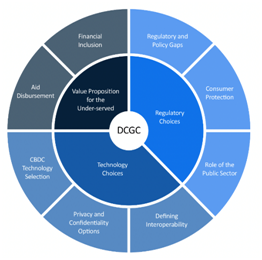

Context
A recent report by the United Nations (UN) stated that over seven percent of India’s population own digital currencies. The adoption of digital currencies has increased challenges in terms of the need to balance accountability, privacy, and transparency.
Background
- Digital currencies are often cited as a tool for financial inclusion which has the potential to change global financial infrastructure.
- Recent developments have heightened global awareness of the opportunities, challenges, and risks posed by new forms of digital currency.
- And as new technologies in the space cut across traditional lines of jurisdictional responsibility, coordination among the public and private sectors, both domestically and internationally, is increasingly required.
Digital Currencies in Governance:
- The Indian government is trying to explore the idea of a national digital currency, and its integration within the governance.
- If digital currencies owned by central banks are authorised, then the central banks will be able to watch over and control every transaction.
- The introduction of central bank digital currency (CBDC) is expected to bring transparency to the industry.
What is the need for cryptocurrency governance?
- Privacy is a big area of concern and to eliminate the scope for regulatory arbitrage there is a need for cryptocurrency regulation.
- As new payment methods appear, appropriate regulatory frameworks become critical.
- Well-placed legislation can go a long way in helping the agencies targeting financial crimes.
>
|
What is Digital Currency?
|
What are the present challenges regarding digital currency?
- Privacy and transparency
- Cyber fraud
- Chances of execution ofunauthorized trades which don’t come under any regulatory framework.
- Concerns over money laundering, terror financing, tax evasion, etc with private cryptocurrencies like Bitcoin, Ether, etc.
How the present challenge around cryptocurrency can be minimized?
- Businesses can practice vigilance against such threats through the application of security measures and the maintenance of blockchain records.
- Protection of networks through the setup of firewalls and encryption of information will minimize the risk of cyber criminals, who intend to gain access to confidential information.
- Proper regulatory legislation will help especially those which target financial crimes.
- Introduction of National Digital Currency: Indian government seeks to explore the idea of a national digital currency, and its integration within the governance.
- If digital currencies owned by central banks are authorized, central banks will be able to watch over and control every transaction.
- The introduction of central bank digital currency (CBDC) is expected to bring transparency to the industry.
Important government initiatives to stop illegal practices around digital currency
- The central government announced to launch of its digital currency (CBDC). RBI has been examining use cases and working out a phased implementation strategy for the introduction of CBDC with little or no disruption.
- The government had been planning at the time to introduce a Bill in Parliament that would prohibit “all private cryptocurrencies in India” with “certain exceptions”.
- In India, legal enablers for a digital currency have been put in place via the Finance Bill, 2022. it proposes that the CBDC "should also be regarded as bank notes”.
- Other measures include decisions related to regulation, improving efficiency, resilience, and competitiveness of payment systems.
- Policymakers are also assessing how to support responsible digital currency innovation while safeguarding or promoting financial stability, financial inclusion, and consumer protection.
|
Central Bank Digital Currency (CBDC)
|
International Initiatives to tackle challenges of digital currency
- Although international bodies have been working on assessing risks and appropriate policy responses to the rise of cryptos, there has been no internationally coordinated regulation of cryptocurrencies.
- The Digital Currency Governance Consortium (DCGC) was launched under the aegis of the World Economic Forum.
|
Digital Currency Governance Consortium
|
Way Forward
The territorial differences, while offering jurisdictional arbitrage opportunities, create uncertainties and an increased compliance burden for businesses operating in the sector. This is exacerbated by the absence of common standards and terminologies.
For a truly global coordinated approach, countries and international organizations must work together, leveraging best practices and learnings from each other. In addition to risk assessments and the establishment of common standards, there is also a pressing need to leverage the technology itself to develop fit-for-purpose and inclusive solutions, through public-private collaboration.



